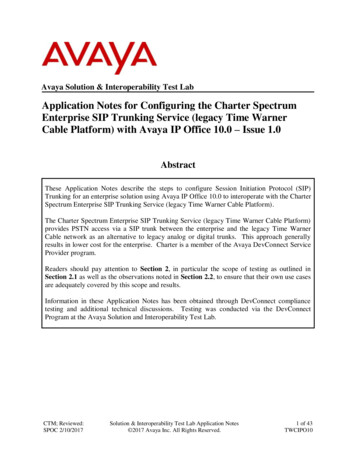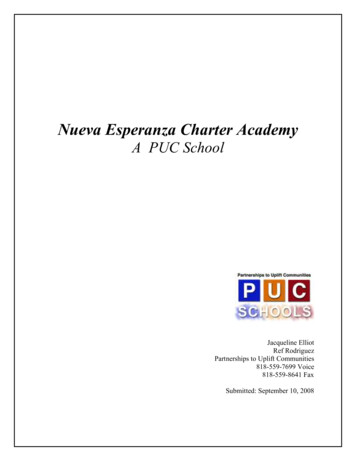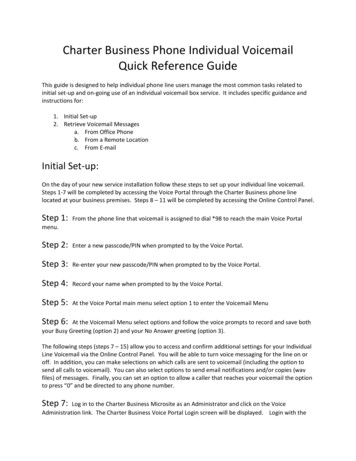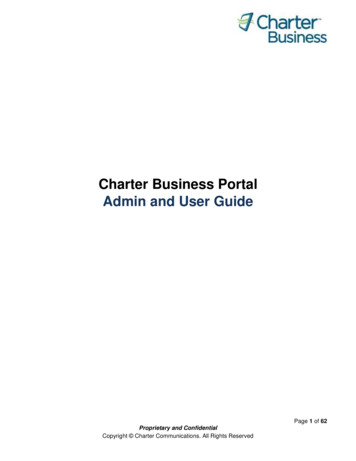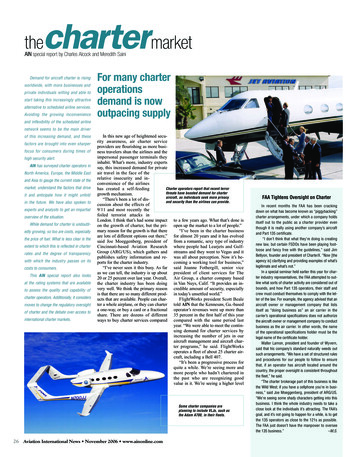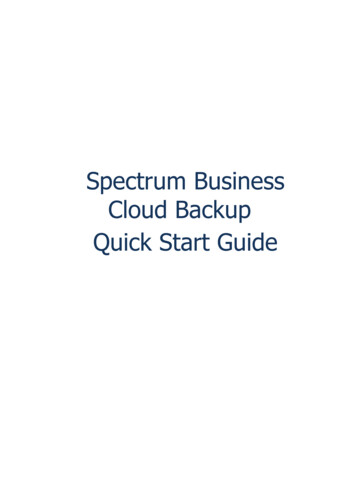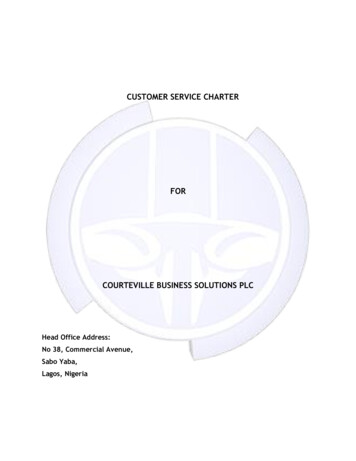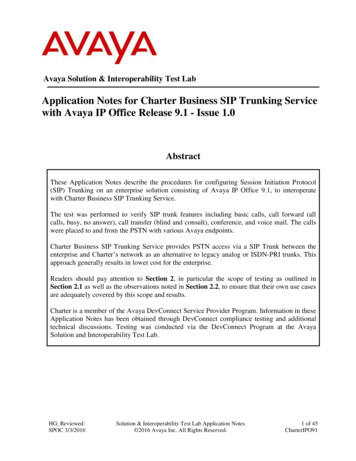
Transcription
Avaya Solution & Interoperability Test LabApplication Notes for Charter Business SIP Trunking Servicewith Avaya IP Office Release 9.1 - Issue 1.0AbstractThese Application Notes describe the procedures for configuring Session Initiation Protocol(SIP) Trunking on an enterprise solution consisting of Avaya IP Office 9.1, to interoperatewith Charter Business SIP Trunking Service.The test was performed to verify SIP trunk features including basic calls, call forward (allcalls, busy, no answer), call transfer (blind and consult), conference, and voice mail. The callswere placed to and from the PSTN with various Avaya endpoints.Charter Business SIP Trunking Service provides PSTN access via a SIP Trunk between theenterprise and Charter’s network as an alternative to legacy analog or ISDN-PRI trunks. Thisapproach generally results in lower cost for the enterprise.Readers should pay attention to Section 2, in particular the scope of testing as outlined inSection 2.1 as well as the observations noted in Section 2.2, to ensure that their own use casesare adequately covered by this scope and results.Charter is a member of the Avaya DevConnect Service Provider Program. Information in theseApplication Notes has been obtained through DevConnect compliance testing and additionaltechnical discussions. Testing was conducted via the DevConnect Program at the AvayaSolution and Interoperability Test Lab.HG; Reviewed:SPOC 3/3/2016Solution & Interoperability Test Lab Application Notes 2016 Avaya Inc. All Rights Reserved.1 of 45CharterIPO91
1. IntroductionThese Application Notes describe the steps necessary for configuring Session Initiation Protocol(SIP) Trunking service between Charter and an Avaya SIP-enabled enterprise solution.In the configuration used during the testing, the Avaya SIP-enabled enterprise solution consisted ofAvaya IP Office 500v2 Release 9.1 (hereafter referred to as IP Office), Avaya Communicator forWindows and Avaya Deskphones, including SIP, H.323, digital, and analog.As a required component of the Charter Business SIP Trunking service offering, Charter will installa Modular Access Router at the customer premises (enterprise site). Charter will perform the initialconfiguration and maintenance as required. The Modular Access Router will be consideredCustomer Premises Equipment (CPE).The Charter Business SIP Trunking Service referenced within these Application Notes is designedfor business customers. Customers using this service with the Avaya IP Office solution are able toplace and receive PSTN calls via a broadband WAN connection using the SIP protocol. Thisconverged network solution is an alternative to traditional PSTN trunks such as analog and/or ISDNPRI trunks. This approach generally results in lower cost for the enterprise.The terms “service provider” or “Charter” will be used interchangeably throughout these ApplicationNotes.2. General Test Approach and Test ResultsThe general test approach was to simulate an enterprise site in the Solution & Interoperability TestLab by connecting IP Office to the Charter Business SIP Trunking service via the public Internet, asdepicted in Figure 1.DevConnect Compliance Testing is conducted jointly by Avaya and DevConnect members. Thejointly-defined test plan focuses on exercising APIs and/or standards-based interfaces pertinent tothe interoperability of the tested products and their functionalities. DevConnect Compliance Testingis not intended to substitute full product performance or feature testing performed by DevConnectmembers, nor is it to be construed as an endorsement by Avaya of the suitability or completeness ofa DevConnect member’s solution.HG; Reviewed:SPOC 3/3/2016Solution & Interoperability Test Lab Application Notes 2016 Avaya Inc. All Rights Reserved.2 of 45CharterIPO91
2.1 Interoperability Compliance TestingTo verify the Charter Business SIP Trunking service offering with Avaya IP Office, the followingfeatures and functionalities were exercised during the compliance testing: Response to SIP OPTIONS queries. Incoming PSTN calls to various Avaya endpoints, including SIP, H.323, digital and analog atthe enterprise. All incoming calls from the PSTN were routed to the enterprise across the SIPTrunk from the service provider networks. Outgoing PSTN calls from Avaya endpoints including SIP, H.323, digital and analogtelephone at the enterprise. All outgoing calls to the PSTN were routed from the enterpriseacross the SIP trunk to the service provider networks. Incoming and outgoing PSTN calls to/from Avaya Communicator for Windows. Dialing plans including local, long distance, outbound toll-free and international. Caller ID presentation and Caller ID restriction. Proper disconnect when the caller abandons the call before the call is answered. Proper disconnect via normal call termination by the caller or the called parties. Proper disconnect by the network for calls that are not answered (with coverage to voicemailoff). Proper response to busy endpoints. Proper response/error treatment when dialing invalid PSTN numbers. Codec G.711MU (Charter supported audio codec). Proper response to no matching codecs. G.711 Fax Pass-through. Proper early media transmissions. Voicemail and DTMF tone support using RFC 2833 (leaving and retrieving voice mailmessages, etc.). Outbound Toll-Free calls, interacting with IVR (Interactive Voice Response systems). Call Hold/Resume (long and short duration). Call Forward (unconditional, busy, no answer). Blind Call Transfers. Consultative Call Transfers. Station Conference. Mobility twinning of incoming calls to mobile phones.Items not supported or not tested included the following: The use of the SIP REFER method for network call redirection is not currently supported byCharter. Inbound toll-free calls and 911 emergency calls are supported but were not tested as part ofthe compliance test. T.38 fax is not supported by Charter; therefore, T.38 fax was not tested. G.711 Fax Passthrough was tested successfully and it’s recommended instead.HG; Reviewed:SPOC 3/3/2016Solution & Interoperability Test Lab Application Notes 2016 Avaya Inc. All Rights Reserved.3 of 45CharterIPO91
2.2 Test ResultsInteroperability testing with Charter Business SIP Trunking service was successfully completed withthe exception of observations/limitations described below: No matching codec on outbound calls: If an unsupported audio codec is received byCharter on the SIP Trunk (e.g., 722), Charter will respond with “480 TemporarilyUnavailable” instead of “488 Not Acceptable Here”, the user will hear re-order tone. Thisissue does not have any user impact, and should not be seen since the codecs will be matchedduring the installation, it is listed here simply as an observation. Inbound calls to an unassigned enterprise extension: IP Office sends a “404 Not Found”message to Charter when it receives calls to an unassigned extension, the user hears re-ordertone instead of the common announcement informing the user that he/she has reached a nonworking number, to please check the number and to try again. This issue is considered nonservice affecting and it’s being investigated by Charter, in order to apply the correctannouncement to the user.2.3 SupportFor support on Charter Business SIP Trunking service visit the corporate Web page at:https://www.charterbusiness.com/ or call 800-314-7195Avaya customers may obtain documentation and support for Avaya products by visitinghttp://support.avaya.com. Alternatively, in the United States, (866) GO-AVAYA (866-462-8292)provides access to overall sales and service support menus.3. Reference ConfigurationFigure 1 illustrates the test configuration used. The test configuration simulates an enterprise sitewith an Avaya SIP-enabled enterprise solution connected to the Charter Business SIP Trunkingservice through the public Internet.The Avaya components used to create the simulated enterprise customer site includes: Avaya IP Office 500v2. Avaya IP Office Voicemail Pro. Avaya 96x0 Series H.323 IP Deskphones. Avaya 96x1 Series H.323 IP Deskphones. Avaya 1100 Series SIP IP Deskphones. Avaya Communicator for Windows. Avaya 1408 Digital Telephones. Avaya 9508 Digital Telephones.In the reference configuration, a Modular Access Router was required at the simulated enterprisesite, acting as a SIP interface between the Avaya enterprise (IP Office) and Charter’s network.Charter will install the Modular Access Router at the customer premises (enterprise site). Charterwill perform the initial configuration and maintenance as required. The Modular Access Router willbe considered Customer Premises Equipment (CPE).HG; Reviewed:SPOC 3/3/2016Solution & Interoperability Test Lab Application Notes 2016 Avaya Inc. All Rights Reserved.4 of 45CharterIPO91
Also located at the simulated enterprise site is Avaya IP Office 500v2 with analog and digitalextension expansion modules, as well as a VCM64 (Voice Compression Module) for supportingVoIP codecs. The IP Office LAN1 port connects to the inside interface (or private side) of Charter’sModular Access Router.The transport protocol between IP Office and Charter’s Modular Access Router, across theenterprise private IP network, is SIP over UDP.For inbound calls, the calls flowed from Charter’s network, across the public Internet, to Charter’sModular Access Router, then to IP Office.Outbound calls to the PSTN were first processed by IP Office. Once IP Office selected the properSIP trunk; the call was routed to Charter’s Modular Access Router, across the public Internet, then toCharter’s network.For the purposes of the compliance test, users dialed a short code of 9 N digits to make calls acrossthe SIP trunk to Charter (refer to Section 5.8). The short code 9 was stripped off by Avaya IP Officebut the remaining N digits were sent unaltered to the network. Since Charter is a U.S. basedcompany, a country member of the North American Numbering Plan (NANP), the users dialed 7 or10 digits for local calls, and 11 (1 10) digits for other calls between the NANP.In an actual customer configuration, the enterprise site may also include additional networkcomponents between Charter and the enterprise. A complete discussion of the configuration of thesedevices is beyond the scope of these Application Notes. However, it should be noted that SIP andRTP traffic between the service provider and the enterprise must be allowed to pass through thesedevices.For confidentiality and privacy purposes, actual public IP addresses and DID numbers used duringthe compliance test have been replaced with fictitious IP addresses and DID numbers throughout theApplication Notes.HG; Reviewed:SPOC 3/3/2016Solution & Interoperability Test Lab Application Notes 2016 Avaya Inc. All Rights Reserved.5 of 45CharterIPO91
Figure 1: Avaya Interoperability Test Lab Configuration.HG; Reviewed:SPOC 3/3/2016Solution & Interoperability Test Lab Application Notes 2016 Avaya Inc. All Rights Reserved.6 of 45CharterIPO91
4. Equipment and Software ValidatedThe following equipment and software/firmware were used for the compliance a IP Office 500v2Avaya IP Office DIG DCPx16 V2Avaya IP Office ManagerAvaya Voicemail Pro ClientAvaya 96x0 IP Deskphones (H.323)Avaya 96x1 Series IP Deskphones (H.323)Avaya 1120E IP Deskphones (SIP)Avaya Communicator for WindowsAvaya Digital Deskphones 1408Avaya Digital Deskphones 9508Lucent Analog PhoneCharterBroadworks Broadsoft Application ServerACME Packet 4500 Series SBCAdtran NetVanta 3430 Modular Access Router9.1.4.0 Build 1379.1.4.0 Build 1379.1.4.0 Build 1379.1.4.0 Build 7Avaya one-X Deskphone EditionS3.230AAvaya one-X Deskphone H.323Version 6.6029SIP1120e Ver. 04.04.18.002.0.3.3340.00.55-AS Rel 17.sp4 1.197SCX6.2.0 MR-9 GA (Build 1014)R10.3.0.VNote: Compliance Testing is applicable when the tested solution is deployed with a standalone IPOffice 500v2 and also when deployed with all configurations of IP Office Server Edition withoutT.38 Fax Service.HG; Reviewed:SPOC 3/3/2016Solution & Interoperability Test Lab Application Notes 2016 Avaya Inc. All Rights Reserved.7 of 45CharterIPO91
5. Configure IP OfficeThis section describes the IP Office configuration required to interwork with Charter Business SIPTrunking service. IP Office is configured through Avaya IP Office Manager (IP Office Manager)which is a PC application. On the PC, select Start Programs IP Office Manager to launchIP Office Manager. Navigate to File Open Configuration, select the proper IP Office from thepop-up window, and log in with the appropriate credentials. A management window will appear asshown in the next sections. The appearance of IP Office Manager can be customized using the Viewmenu (not shown). In the screenshots presented in this section, the View menu was configured toshow the Navigation Pane on the left side and the Details Pane on the right side. These panes willbe referenced throughout these Application Notes.These Application Notes assume the basic installation and configuration of IP Office have alreadybeen completed and are not discussed here. For further information on IP Office, please consultReferences in Section 9.5.1 LicensingThe configuration and features described in these Application Notes require the IP Office system tobe licensed appropriately. If a desired feature is not enabled or there is insufficient capacity, contactan authorized Avaya sales representative.To verify that there is a SIP Trunk Channels License with sufficient capacity; click License in theNavigation pane and SIP Trunk Channels in the Group pane. Confirm that there is a valid licensewith sufficient “Instances” (trunk channels) in the Details pane. Note that the full License Keys inthe screen below is not shown for security purposes.HG; Reviewed:SPOC 3/3/2016Solution & Interoperability Test Lab Application Notes 2016 Avaya Inc. All Rights Reserved.8 of 45CharterIPO91
5.2 SystemConfigure the necessary system settings. In an Avaya IP Office, the LAN2 tab settings correspond tothe Avaya IP Office WAN port (public network side) and the LAN1 tab settings correspond to theLAN port (private network side). For the compliance test, the LAN1 interface was used to connectAvaya IP Office to the enterprise private network (LAN), LAN2 was not used.5.2.1 System - LAN1 TabIn the sample configuration, the MAC address 00E00706530F was used as the system name. TheLAN port connects to Charter’s Modular Access Router, across the enterprise LAN (private)network. The LAN1 settings correspond to the LAN port in IP Office. To access the LAN1 settings,navigate to System (1) 00E00706530F in the Navigation Pane then in the Details Pane navigateto the LAN1 LAN Settings tab. The LAN1 settings for the compliance testing were configuredwith following parameters: Set the IP Address field to the LAN IP address, e.g. 172.16.5.60. Set the IP Mask field to the subnet mask of the public network, e.g. 255.255.255.0. All other parameters should be set according to customer requirements. Click OK to commit (not shown).HG; Reviewed:SPOC 3/3/2016Solution & Interoperability Test Lab Application Notes 2016 Avaya Inc. All Rights Reserved.9 of 45CharterIPO91
The VoIP tab as shown in the screenshot below was configured with following settings: Check the H323 Gatekeeper Enable to allow Avaya IP Telephones/Softphone using theH.323 protocol to register. Check the SIP Trunks Enable to enable the configuration of SIP Trunk connecting toCharter. Check the SIP Registrar Enable to allow Avaya IP Telephones/Softphone to register usingthe SIP protocol. Enter the Domain Name of the enterprise under Domain Name. Verify the UDP Port and TCP Port numbers under Layer 4 Protocol are set to 5060. Verify the RTP Port Number Range settings for a specific range for the RTP traffic. ThePort Range (Minimum) and Port Range (Maximum) values were kept as default. In the Keepalives section at the bottom of the page, set the Scope field to RTP, PeriodicTimeout to 30, and Initial keepalives to Enabled. This will cause the IP Office to send RTPkeepalive packets at the beginning of the calls and every 30 seconds thereafter if no otherRTP traffic is present. All other parameters should be set according to customer requirements. Click OK to commit (not shown).HG; Reviewed:SPOC 3/3/2016Solution & Interoperability Test Lab Application Notes 2016 Avaya Inc. All Rights Reserved.10 of 45CharterIPO91
In the Network Topology tab, configure the following parameters: Select the Firewall/NAT Type from the pull-down menu to the option that matches thenetwork configuration. In the compliance testing, it was set to Open Internet. With thisconfiguration, even though the default STUN settings are populated, they will not be used. Set the Binding Refresh Time (seconds) to a desired value, the value of 300 (or every 5minutes) was used during the compliance testing. This value is used to determine thefrequency that IP Office will send OPTIONS heartbeat to the service provider. Verify the Public IP Address is set to 0.0.0.0. Set the Public Port to 5060 for UDP. All other parameters should be set according to customer requirements. Click OK to commit (not shown).HG; Reviewed:SPOC 3/3/2016Solution & Interoperability Test Lab Application Notes 2016 Avaya Inc. All Rights Reserved.11 of 45CharterIPO91
5.2.2 System - Telephony TabNavigate to the Telephony Telephony Tab in the Details Pane, configure the followingparameters: Choose the Companding Law typical for the enterprise location, U-Law was used. Uncheck the Inhibit Off-Switch Forward/Transfer box to allow call forwarding and calltransfers to the PSTN via the SIP trunk to the service provider. All other parameters should be set according to customer requirements. Click OK to commit (not shown).HG; Reviewed:SPOC 3/3/2016Solution & Interoperability Test Lab Application Notes 2016 Avaya Inc. All Rights Reserved.12 of 45CharterIPO91
5.2.3 System - Twinning TabNavigate to the Twinning tab on the Details Pane, configure the following parameters: Uncheck the Send original calling party information for Mobile Twinning box. This willallow the Caller ID for Twinning to be controlled by the setting on the SIP Line (Section5.4). This setting also impacts the Caller ID for call forwarding. Click OK to commit (not shown).HG; Reviewed:SPOC 3/3/2016Solution & Interoperability Test Lab Application Notes 2016 Avaya Inc. All Rights Reserved.13 of 45CharterIPO91
5.2.4 System - Codecs TabFor Codec’s settings, navigate to the System (1) 00E00706530F in the Navigation Pane, selectthe Codecs tab and configure the following parameters: The RFC2833 Default Payload field is new in IP Office release 9.1. It allows the manualconfiguration of the payload type used on SIP calls that are initiated by the IP Office. Thedefault value 101 was used. For Codec Selection, select the codecs and codec order of preference on the right, under theSelected column. The Default Codec Selection area enables the codec preference order to beconfigured on a system-wide basis. The buttons between the two lists can be used to movecodecs between the Unused and Selected lists, and to change the order of the codecs in theSelected codecs list. By default, all IP lines and phones (SIP and H.323) will use the systemdefault codec selection shown here, unless configured otherwise for a specific line orextension. The example below shows the codecs used for IP phones (SIP and H.323), thesystem’s default codecs and order was used. Click OK to commit (not shown).Note: The codec selections defined under this section (System – Codecs Tab) are the codecs selectedfor the IP phones/extensions. The codec selections defined under Section 5.4.6 (SIP Line – VoIPtab) are the codecs selected for the SIP Line (Trunk).HG; Reviewed:SPOC 3/3/2016Solution & Interoperability Test Lab Application Notes 2016 Avaya
the SIP trunk to Charter (refer to Section 5.8). The short code 9 was stripped off by Avaya IP Office but the remaining N digits were sent unaltered to the network. Since Charter is a U.S. based company, a country member of the No
